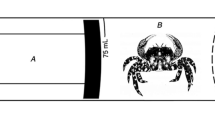Summary
The salp Thalia democratica has one of the highest rates of population increase of any multicellular animal.
Age distribution and survivorship were calculated for a natural population at sea, using serial size distributions and known age-length relationship. Methods were developed to estimate infinitesimal rate of population increase r, even though the birth-rate was highly periodic and the sampling period did not cover a full cycle of birth-rate. Values of r between 0.47 and 0.91 per day, indicate that this population was increasing by between 1.6 times and 2.5 times per day.
Comparison of the salp with other organisms shows that its rate of population increase is close to the rates of increase of the algae and other micro-organisms on which it feeds. Examination of the factors contributing to high rate of increase in the salp, emphasize the ecological characteristics required in a colonizing species.
Similar content being viewed by others
References
Apstein, C.: Salpen der deutschen Tiefsee-Expedition. Wiss. Ergebnisse der Deutsch. Tiefs.-Expedit. 1898–1899, 12, 1–46 (1906).
Bateman, M. A.: Adaptation to temperature in geographic races of the Queensland fruit fly, Dacus (Strumeta) tryoni. Aust. J. Zool. 15, 1141–1161 (1967).
Birch, L. C.: The intrinsic rate of natural increase of an insect population. J. anim. Ecol. 17, 15–26 (1948).
Bourgeois-Pichat, J.: Utilisation de la notion de population stable pour mesurer la mortalite et la fecondite des populations des pays sous-developpes. Bulletin de l'Institut International de Statistique (Actes de la 30e Session) 1957.
Caughley, G.: Parameters for seasonally breeding populations. Ecology 48, 834–839 (1967).
Caughley, G.: Eruption of ungulate populations, with emphasis on Himalayan thar in New Zealand. Ecology 51, 53–72 (1970).
Cole, L. C.: The population consequences of life history phenomena. Quart. Rev. Biol. 29, 103–137 (1954).
Fenchel, T.: The ecology of marine microbenthos. III. The reproductive potential of Ciliates. Ophelia 5, 123–136 (1968).
Hall, D. J.: An experimental approach to the dynamics of a natural population of Daphnia galeata mendota. Ecology 45, 94–110 (1964).
Heip, C.: The reproductive potential of copepods in brackish water. Mar. Biol. 12, 219–221 (1972).
Heron, A. C.: Population ecology of a colonizing species: the pelagic tunicate Thalia democratica. I. Individual growth rate and generation time. Oecologia (Berl.) 10, 269–293 (1972).
Hughes, R. D.: A method of estimating the effects of mortality on aphid populations. J. anim. Ecol. 31, 389–396 (1962).
Humphrey, G. F.: Seasonal variation in plankton pigments in waters off Sydney. Aust. J. mar. Freshwat. Res. 14, 24–36 (1963).
Keyfitz, N.: Introduction to the mathematics of population. Reading, Mass.: Addison-Wesley 1968.
King, C. E.: Food, age, and the dynamics of a laboratory population of rotifers. Ecology 48, 111–128 (1967).
Kott, P.: Onshore planktological investigations in eastern Australia, 1945–54. CSIRO Aust. Oceanogr. Stn List 19, 1–170 (1954).
Lambert, C. C., Brandt, C. L.: The effect of light on the spawning of Ciona intestinalis. Biol. Bull. 132, 222–228 (1967).
Laughlin, R.: Capacity for increase: a useful population statistic. J. anim. Ecol. 34, 77–91 (1965).
Lewontin, R. C.: Selection for colonizing ability. In: Baker, H. G., Stebbins, G. L., (eds.), The genetics of colonizing species. New York: Academic Press 1965.
Lotka, A. J.: Elements of physical biology. Baltimore: Williams & Wilkins 1925 (republished by Dover Publications, 1956).
Murphy, G. I.: Vital statistics of the Pacific sardine (Sardinops caerulea) and the population consequences. Ecology 48, 731–736 (1967).
Sewell, R. B. S.: The salps of the Indian seas. Rec. Ind. Mus. 28, 65–126 (1926).
Sewell, R. B. S.: The pelagic tunicata. Brit. Mus. (Nat. Hist.) John Murray Exped. 1933–34. Sci. Repts. 10, 1–90 (1953).
Sheard, K.: Species groups in the zooplankton of eastern Australian slope waters, 1938–41. Aust. J. mar. Freshwat. Res. 16, 219–254 (1965).
Slobodkin, L. B.: Growth and regulation of animal populations. New York: Holt, Rinehart and Winston 1963.
Smith, F. E.: Quantitative aspects of population growth. In: Dynamics of growth processes, E. Boell (ed.). Princeton, N. J.: Princeton University Press 1954.
Author information
Authors and Affiliations
Rights and permissions
About this article
Cite this article
Heron, A.C. Population ecology of a colonizing species: The pelagic tunicate Thalia democratica . Oecologia 10, 294–312 (1972). https://doi.org/10.1007/BF00345734
Received:
Issue Date:
DOI: https://doi.org/10.1007/BF00345734




